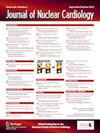[99mTc]Tc-HMDP SPECT/CT心肌血比检测ATTR型心肌病的验证
IF 3
4区 医学
Q2 CARDIAC & CARDIOVASCULAR SYSTEMS
引用次数: 0
摘要
背景:本研究验证了99mTc-羟亚甲基二膦酸盐([99mTc]Tc-HMDP)单光子发射断层扫描/计算机断层扫描(SPECT/CT)应用心肌血比(MBR)诊断甲状腺素淀粉样变性(ATTR)型心肌病的准确性。方法:最终研究人群为80例在赫尔辛基大学医院或芬兰Jorvi中心医院接受[99mTc]Tc-HMDP SPECT/CT诊断疑似ATTR型心肌病的患者。根据目前接受的欧洲心脏病学会标准,患者被诊断为非ATTR (n=48)或ATTR心肌病患者(n=32)。用左室最大心肌摄取与左房最大摄取之比计算左室MBR。以右心室游离壁和右心房的最大摄取比计算右心室摄食量。数据以平均值±标准差表示。结果:ATTR患者的左室MBR高于非ATTR患者(4.6±1.2 vs 0.9±0.2)。结论:[99mTc]Tc-HMDP SPECT/CT检测ATTR心肌病时,左室心肌血比(MBR)大于1.5的准确率为100%。左心室MBR与超声心动图上的壁厚相关,但与ATTR心肌病的临床严重程度无关。本文章由计算机程序翻译,如有差异,请以英文原文为准。
Validation of [99mTc]Tc-HMDP SPECT/CT myocardium-to-blood ratio for the detection of ATTR cardiomyopathy
Background
This study validates the accuracy of 99mTc-hydroxymethylene diphosphonate ([99mTc]Tc-HMDP) single-photon emission tomography/computed tomography (SPECT/CT) in the diagnosis of transthyretin amyloidosis (ATTR) cardiomyopathy using myocardium-to-blood ratio (MBR).
Methods
The final study population was 80 patients who underwent [99mTc]Tc-HMDP SPECT/CT for suspected ATTR cardiomyopathy at Helsinki University Hospital or Jorvi Central Hospital in Finland. Patients were diagnosed according to the currently accepted European Society of Cardiology criteria as either non-ATTR (n = 48) or ATTR cardiomyopathy patients (n = 32). The left ventricular (LV) MBR was calculated by dividing LV maximal myocardial uptake with maximal left atrial uptake. Right ventricular (RV) uptake was calculated as the maximal uptake ratio on the RV-free wall and right atrium. Data are presented as mean ± standard deviation.
Results
The LV MBR was higher in ATTR patients than in non-ATTR patients (4.6 ± 1.2 vs .9 ± .2, P < .001). The LV MBR of 1.5 identified ATTR cardiomyopathy with 100% accuracy. LV MBR was associated with LV wall thickness on echocardiography in univariable analysis but not with LV ejection fraction or E/e’. The RV MBR was higher in ATTR patients (2.9 ± 1.0 vs .8 ± .2, P < .001). Neither LV nor RV MBR were associated with the clinical severity of ATTR cardiomyopathy in univariable analysis.
Conclusions
LV myocardium-to-blood ratio (MBR) greater than 1.5 was 100% accurate for detecting ATTR cardiomyopathy using [99mTc]Tc-HMDP SPECT/CT. Left ventricular MBR was associated with wall thickness on echocardiography but not with the clinical severity of ATTR cardiomyopathy.
求助全文
通过发布文献求助,成功后即可免费获取论文全文。
去求助
来源期刊
CiteScore
5.30
自引率
20.80%
发文量
249
审稿时长
4-8 weeks
期刊介绍:
Journal of Nuclear Cardiology is the only journal in the world devoted to this dynamic and growing subspecialty. Physicians and technologists value the Journal not only for its peer-reviewed articles, but also for its timely discussions about the current and future role of nuclear cardiology. Original articles address all aspects of nuclear cardiology, including interpretation, diagnosis, imaging equipment, and use of radiopharmaceuticals. As the official publication of the American Society of Nuclear Cardiology, the Journal also brings readers the latest information emerging from the Society''s task forces and publishes guidelines and position papers as they are adopted.

 求助内容:
求助内容: 应助结果提醒方式:
应助结果提醒方式:


